“Comanche”, which did not reach
In December 1982, a report was prepared, entitled "Research in the field of application aviation US Army ”, this report proved the inability of the obsolete Bell OH-58 and Bell AN-1 helicopters to solve combat tasks in the face of counteracting the air defense of the Warsaw Pact states. The following year, the US Department of Defense announced the start of work on a new light multi-purpose helicopter under the Light Helicopter Experimental - LHX program. The new combat vehicle was planned to be developed in two versions - multipurpose (UTIL) and reconnaissance-strike (SCAT).
The technical assignment issued by the US military contained a number of complex and difficult tasks at that time. The helicopter was to successfully perform combat missions in all climatic zones, day and night, in flat and highlands. The key point was the requirements that related to the maximum airspeed, which at 180 km / h exceeded the speed of any helicopter in service. The machine, created in the framework of the project LHX, was supposed to reach speeds of about 500 km / h. The second very important task was to reduce the visibility of the helicopter in the radar, infrared and acoustic ranges.
The creation of a rotary-wing machine under the LHX program was to be held on a competitive basis. From the standpoint of today’s days, the appetites of the American generals can be astounding. In the interests of the army alone, it was intended to order almost 5 thousands of helicopters: 1100 in the SCAT version to replace the AH-1 “Cobra” attack helicopters, 1800 to replace the OH-6 “Hughes” and OH-58 “Kiowa” and 2000 machines in the UTIL variant Replace multipurpose UH-1 "Huey". In addition, orders for the helicopter could follow from the Marine Corps and the Air Force, and the total amount of the order to make 6 thousands of machines. The total cost of developing helicopters was estimated at 2,8 billion dollars, and the cost of their production would be 36 billion dollars, which would automatically make the LHX program the most ambitious of all existing helicopter programs.
A firm that would have secured victory in this competition would have received orders, and therefore profit for the next 20-25 years. The fairly tough competition for the right to create a new attack helicopter was entered by 4 of large US aircraft building companies - the Boeing-Vertol, Sikorsky, Bell and Hughes firms. At the same time, the projects that were presented by these companies were very different from each other. So the company "Sikorsky" offered a coaxial helicopter with an additional pusher propeller installed in the annular fairing. It was assumed that such a project is the most technically advanced, but it also has a high degree of risk, in particular, due to the use of a coaxial scheme, which is almost never used in the West.
The Bell company, which had extensive experience in creating aircraft with turning screws, promoted a project created on the basis of an experimental convertoplane XV-15. Hughes offered a light winged helicopter based on a single-rotor scheme without a tail rotor. In this project, a jet of jet gases from the engine was used to balance the reactive moment of the rotor and create additional thrust in the longitudinal direction. A similar project, but with a tail rotor in the annular channel, was demonstrated by Boeing Vertol. In this case, a common place in all projects was only the placement of weapons on the internal suspension.
In 1984-1987 in the United States, an assessment of the submitted projects was conducted. Its outcome was a revision of key requirements. This mainly concerned flight speed. Special studies have shown that at altitudes around 15 meters and speeds of more than 320-350 km / h, the crew will find it extremely difficult to simultaneously drive and perform the tactical tasks they face. Especially if it happens in bad weather or at night. It was completely impossible to fight by helicopter developing the speed of 500 km / h. This conclusion allowed to abandon the most exotic projects, the embodiment of which was associated with a significant proportion of risk. At the same time, due to reduced funding, it was decided to abandon the creation of a multi-purpose version of the UTIL helicopter. For the helicopter, only reconnaissance and percussion functions were left, and the total number of supposed machines was reduced to 2096 units.
Despite the reduction of solved tasks, further work within the framework of the LHX project still required unforeseen large expenses. Financial and technical problems led to the fact that the contestants were combined into two groups: Bell-McDonnell-Douglas "(the latter swallowed the company" Hughes ") and" Boeing-Sikorsky. " Companies presented their projects in 1990 year. But at that time, the Soviet Union essentially surrendered its positions, and the probability of a big war in Europe was significantly reduced. Against this background, a possible order was once again provided, which was reduced to 1292 helicopters.
In January, 1991, it was announced that the competition won the Boeing-Sikorsky tandem. At the same time, the nameless car until then was officially named the RAH-66 “Comanche”. By tradition, American helicopters are named after the tribes of North American Indians - "Apache", "Chinook", "Kiowa" - still "air cavalry". The designation RAH (reconnaisence and attack helicopter) was given to the American helicopter for the first time in stories. In the American army, attack helicopters designated AN (attack helicopter), and light vehicles intended for observation and reconnaissance of HE (observation helicopter). At the same time, the new helicopter was not inferior in its capabilities to strike machines and was the first truly reconnaissance helicopter in the American army, therefore the presence of the letter R in its name is not accidental.
The Boeing-Sikorsky Association received a contract for the development and construction of two RAH-66 Comanche helicopters. It was about demo copies. At the same time, all the most complex and “critical” technologies were tried to be tested on flying laboratories or stands. The glider of the helicopter was made entirely of composite materials. To test it, the Sikorsky S-75 helicopter was built and tested, on which the glider shape change was also checked by the EPR value - the effective scattering surface. Apparently, the helicopter S-75 was the first in the world, made using the elements of technology "stealth".
The main elements of the fuselage of the new RAH-66 Comanche helicopter were box girders made from composite materials. Inside this beam was located central fuel tank with a capacity of 1142 liters. From the outside, all the main helicopter units were installed on the beam, which were covered with special large-size panels that formed the outer contour of the machine. The shell of the helicopter was unloaded and with the appearance of combat damage - holes from 23-mm projectiles and 12,7-mm bullets, the loss of its strength did not occur. There was no armor per se on the helicopter, only the pilot’s seats had light protection. The cockpit floor consisted of safely damaged panels that were supposed to absorb the impact energy during a possible accident. For access to various components and systems when performing maintenance about 40% of the fuselage surface were made in the form of removable panels. Due to the features of the installed chassis, the helicopter could “squat” on it in order to reduce the height when transported by air.
The layout of the helicopter was traditional, but had a bright highlight. She was to accommodate the crew, which was different from other helicopters. The pilot was in the front seat, and the weapon operator was in the back. As a result, the pilot had an excellent overview, which was especially important when flying near the ground, as well as during air combat. At the same time, the weapons operator retained all his capabilities in finding targets. This was achieved through the implementation of the “eye outside the cabin” concept. Thermal imaging and infrared viewing systems of the front hemisphere related to the second generation of such devices were installed on the Comanche. They made it possible to see on 40% further and to produce a sharper image in 2 times than similar systems on Apache attack helicopters.
Especially for the new helicopter guided missiles were not created. The available weapons bays were suitable for the existing Stinger air-to-air missiles and the Hellfire ATGM. On the inner surface of the casement compartments, 6 armament suspension units were installed (3 on each leaflet), on any of them it was possible to install an 2 SD "Stinger", one ATGM "Hellfire" or a container with NAR. In addition, the helicopter was equipped with a triple-barreled 20-mm cannon, ammunition which ranged from 320 to 500 shells. The gun had a variable rate of fire. When firing at aerial targets, it was 1500 rds / min, while firing at ground targets - 750 rds / min. In the case of the use of a strike helicopter under the conditions of a relatively weak enemy air defense, the armament could be significantly enhanced by the use of additional suspension units mounted on small attachable wings. These wings could be delivered in the field in just 15 minutes. In this configuration, the helicopter was able to carry up to 14 ATGM "Hellfire", only 2 missiles less than the "Apache". True, the maximum flight speed in this mode was reduced by 20 km / h due to the increase in the drag of the vehicle.
Special attention was paid to reducing the radar visibility of the helicopter. The achievement of this goal was promoted by a convex fuselage shape with flat surfaces, the use of a rotor hub spatula, a retractable landing gear, a radio absorbing coating for the blades and the fuselage, and even a cannon cleared into a special fairing. All these activities significantly reduced the visibility of the car.
In order to reduce the visibility of the helicopter, the Americans achieved a real triumph. The EPR value of the RAH-66 Comanche was 1 / 600 from the EPR of the Apache helicopter and 1 / 200 from the EPR of the Kiowa helicopter. This allowed the helicopter to go unnoticed for longer by the enemy radar. The noise of the main rotor was also significantly reduced - 2 times as compared to Apache, which allowed the helicopter to sneak up on enemy positions by 40% closer. Another success was the reduction of thermal radiation of the power plant to 25% from the usual level. For the first time, the Comanche system was used to suppress infrared radiation (previously, various nozzles for engine nozzles were used to reduce infrared radiation), in which hot exhaust gases of engines were mixed with ambient air and then thrown down through two special flat slits that ran along the ledge along the entire length of the tail boom of the machine. Thanks to these solutions for the air defense radar, as well as missiles equipped with radar and infrared guidance heads, the RAH-66 Comanche helicopter was a difficult target.
Of course, the tests carried out revealed a number of serious problems with the machine, primarily with electronics. It also turned out that the weight of an empty helicopter is significantly greater than the calculated one. Because of this, all the flight characteristics of the helicopter, in particular its rate of climb, were lower than originally stated. In fairness it should be noted that the manufacturer eliminated all the flaws in a fairly fast pace. The 6 first RAH-66 Comanche helicopter gunships were to go into service in the 2002 year, and by 2010, the number of helicopters in the front-line units should have been 72 machines. However, even such a significant reduction in the order did not help. 23 February 2004, the US Congress decided to close the program. By this time, the development has already managed to eat more than 7 billion dollars. Thus, the program to create a Comanche helicopter was thwarted, becoming one of the most expensive programs with such an unenviable fate.
It is believed that such a difficult decision was made on the basis of a detailed analysis of modern military operations, the use of helicopters and their losses in Afghanistan, Iraq and Chechnya. In all these conflicts, most of the rotary-winged machines were shot down with the help of MANPADS equipped with a combined guidance system (including a thermal imaging channel), small-caliber anti-aircraft artillery, or even completely weapons. Against these short-range weapons, no stealth technology used on the RAH-66 Comanche and costing huge sums of money helped. In addition, the helicopter was not armor. Based on this, many American generals decided that RAH-66 is not suitable for use in the conditions of those military conflicts that are widespread in the modern world. With the passing into the past of the global confrontation in Europe, the conditions for which this helicopter was created have disappeared.
Flight specifications of the RAH-66 Comanche:
Overall specifications: length - 14,28 m, fuselage length (without gun) - 12,9 m, maximum fuselage width - 2,04 m, height to the main rotor - 3,37 m, main rotor diameter - 12,9 m, fenestron diameter - 1,37 m.
The area swept by the rotor - 116,74 м2.
Normal take-off weight - 5601 kg, empty weight - 4218 kg, maximum take-off weight - 7896 kg.
Fuel tank capacity - 1142 l (only internal).
The power plant - the turboshaft LHTEC T800-LHT-801 with the power 2x1563 hp
Maximum speed - 324 km / h.
Cruising speed - 306 km / h.
Combat radius - 278 km.
Crew - 2 man (pilot and weapon operator).
The armament is a triple-barreled 20-mm cannon (500 shells), the inner compartment is up to the 6 ATGM Hellfire or 12 SAM-Stinger. External Suspension - up to 8 ATGM Hellfire, up to 16 SAM Stinger, 56x70-mm HAP Hydra 70 or 1730 l in PTB.
Information sources:
http://tvzvezda.ru/news/vstrane_i_mire/content/201412160931-qmbf.htm
http://www.dogswar.ru/oryjeinaia-ekzotika/aviaciia/4571-boevoi-vertolet-rah-.html
http://www.airwar.ru/enc/ah/rah66.html
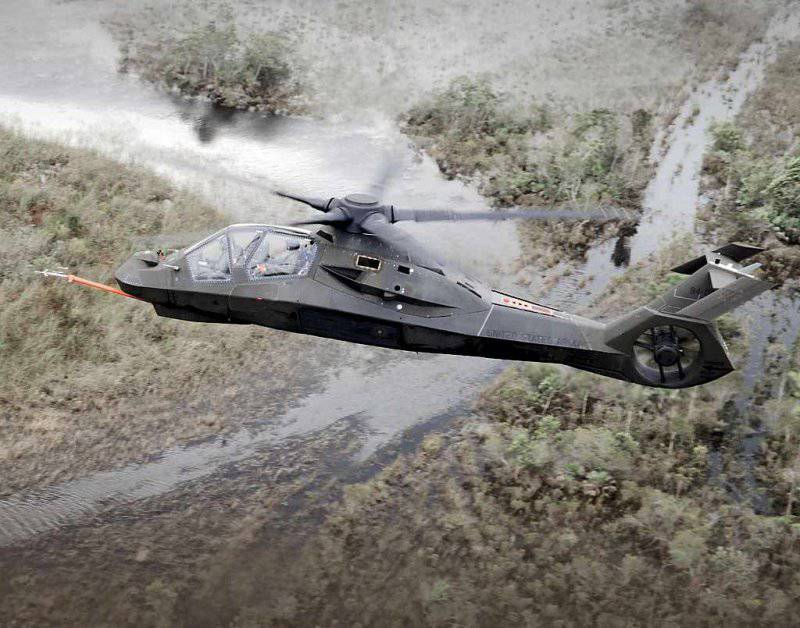
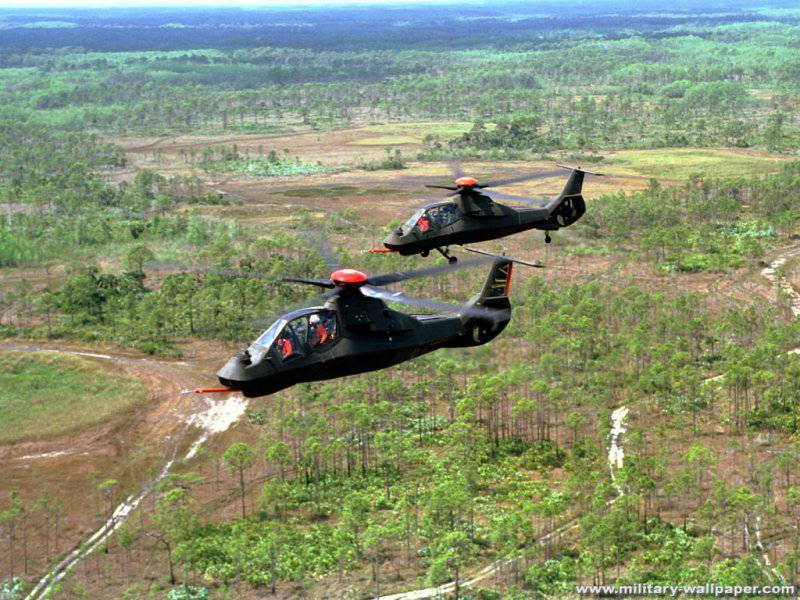
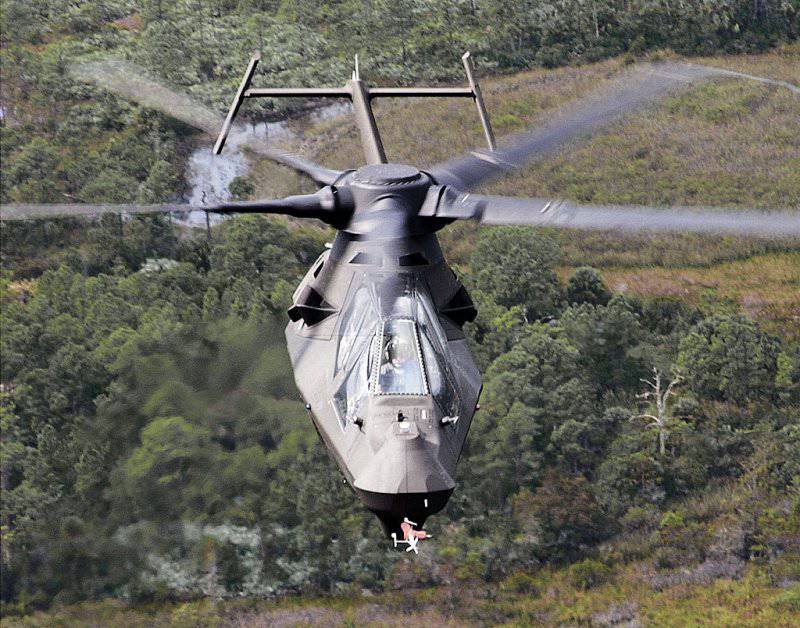
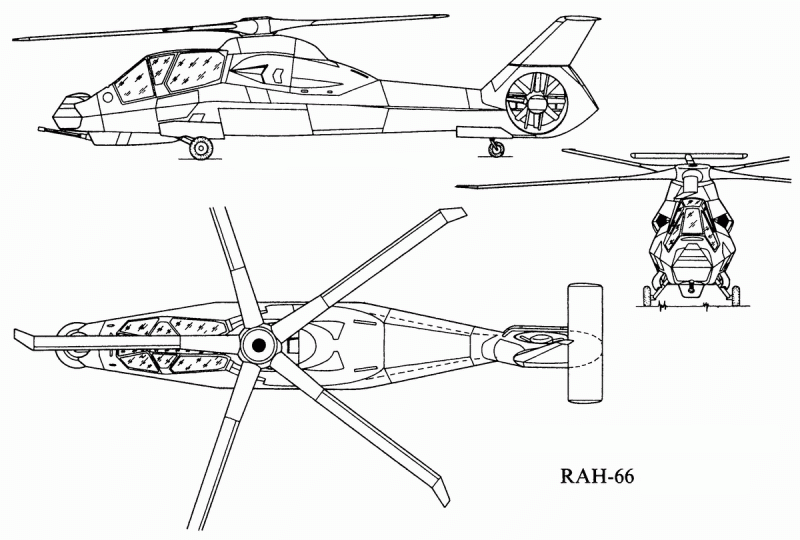
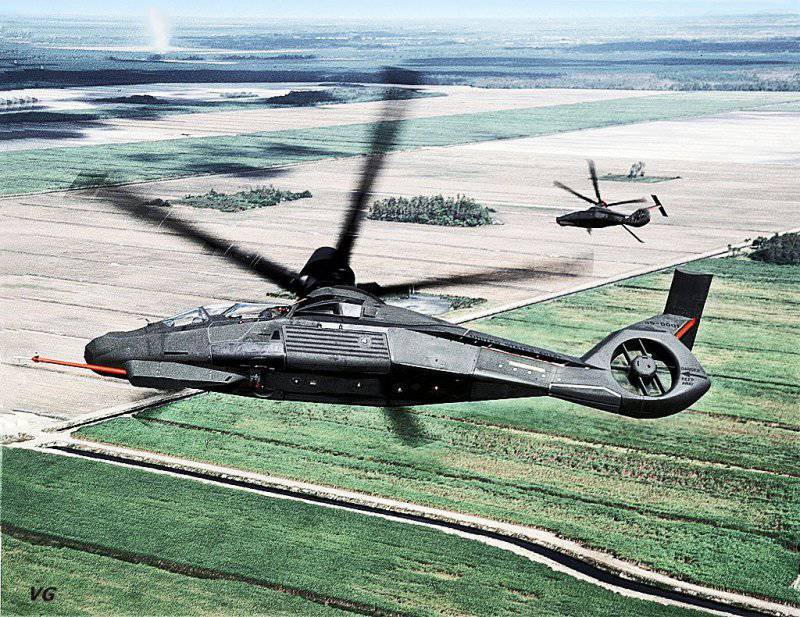
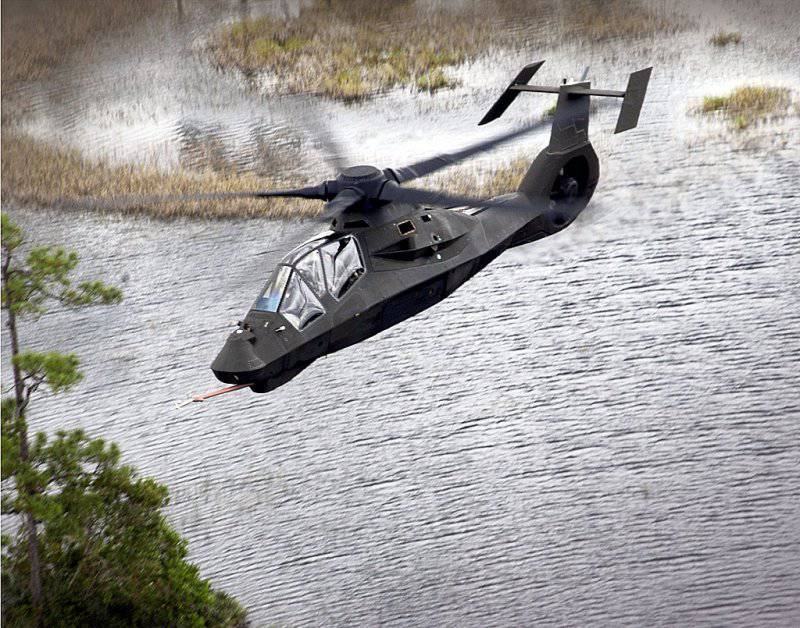
Information